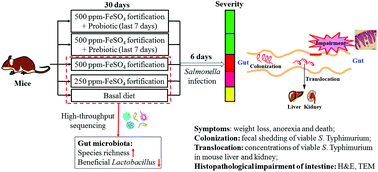当前位置:
X-MOL 学术
›
Food Funct.
›
论文详情
Our official English website, www.x-mol.net, welcomes your
feedback! (Note: you will need to create a separate account there.)
Probiotic/prebiotic correction for adverse effects of iron fortification on intestinal resistance to Salmonella infection in weaning mice†
Food & Function ( IF 5.1 ) Pub Date : 2018-01-02 00:00:00 , DOI: 10.1039/c7fo00990a Feifei Lin 1, 2, 3, 4 , Haohao Wu 1, 2, 3, 4 , Mingyong Zeng 1, 2, 3, 4 , Guangli Yu 2, 3, 4, 5 , Shiyuan Dong 1, 2, 3, 4 , Huicheng Yang 6, 7, 8
Food & Function ( IF 5.1 ) Pub Date : 2018-01-02 00:00:00 , DOI: 10.1039/c7fo00990a Feifei Lin 1, 2, 3, 4 , Haohao Wu 1, 2, 3, 4 , Mingyong Zeng 1, 2, 3, 4 , Guangli Yu 2, 3, 4, 5 , Shiyuan Dong 1, 2, 3, 4 , Huicheng Yang 6, 7, 8
Affiliation

|
Iron fortification has been associated with a modest increase in diarrhea risk among children. Herein, we investigate the correction for this unwanted side effect with probiotic/prebiotic supplementation in weaning mice. Iron fortification with 250 ppm and 500 ppm ferrous sulfate for 30 days significantly increased the species richness of the mouse gut microbiota compared to controls. The 500 ppm-FeSO4 diet caused a significantly decreased abundance of potentially beneficial Lactobacillus. During infection with the foodborne pathogen Salmonella enterica serovar Typhimurium (S. Typhimurium), mice on the 500 ppm-FeSO4 diet showed earlier appearance of poisoning symptoms, higher rates of weight and appetite loss, and lower survival rates, all of which were effectively reversed by supplementation with a probiotic (Lactobacillus acidophilus) or a prebiotic (inulin) for 7 days before infection. Iron fortification with 500 ppm ferrous sulfate also increased fecal shedding and spleen and liver load of viable S. Typhimurium, suggesting its promoting effect on pathogen colonization and translocation, and this negative effect was found to be well corrected by supplementation with Lactobacillus acidophilus or inulin. Light and transmission electron microscopic observation on the ileal villus structure revealed the histopathological impairment of the intestine by iron fortification with both 250 ppm and 500 ppm ferrous sulfate, and the intestinal lesions were markedly alleviated by supplementation with Lactobacillus acidophilus or inulin. These results provide experimental evidence for the increased diarrhea risk upon iron fortification with high pathogen load, and demonstrate that probiotic or prebiotic supplementation can be used to eliminate the potential harm of iron fortification on gut health.
中文翻译:

益生菌/益生元校正,以防止铁强化对断奶小鼠肠道沙门氏菌感染的抵抗性†
铁的强化与儿童腹泻风险的适度增加有关。本文中,我们研究了在断奶小鼠中使用益生菌/益生元补充剂对这种不良副作用的纠正。与对照组相比,用250 ppm和500 ppm的硫酸亚铁强化30天可显着增加小鼠肠道菌群的物种丰富度。500 ppm-FeSO 4饮食导致潜在有益乳杆菌的丰度大大降低。在感染期间与食源性病原体沙门氏菌鼠伤寒沙门氏菌(小号。鼠伤寒沙门氏菌),在500ppm的-的FeSO小鼠4饮食显示中毒症状的出现较早,体重和食欲下降的比率较高,存活率较低,在感染前7天补充益生菌(嗜酸乳杆菌)或益生元(菊粉)可以有效地逆转所有这些症状。用500 ppm的硫酸亚铁强化铁还可以增加粪便的排出量和脾脏,并增加可行S的肝负荷。鼠伤寒表明其对病原菌的定殖和转运具有促进作用,发现这种不良反应可以通过补充嗜酸乳杆菌得到很好的纠正。或菊粉。对回肠绒毛结构的光镜和透射电镜观察表明,通过用250 ppm和500 ppm的硫酸亚铁强化,肠对肠的组织病理学损害,并且通过添加嗜酸乳杆菌或菊粉显着缓解了肠病变。这些结果提供了在高病原体含量的铁强化后腹泻风险增加的实验证据,并证明益生菌或益生元补充剂可用于消除铁强化对肠道健康的潜在危害。
更新日期:2018-01-02
中文翻译:

益生菌/益生元校正,以防止铁强化对断奶小鼠肠道沙门氏菌感染的抵抗性†
铁的强化与儿童腹泻风险的适度增加有关。本文中,我们研究了在断奶小鼠中使用益生菌/益生元补充剂对这种不良副作用的纠正。与对照组相比,用250 ppm和500 ppm的硫酸亚铁强化30天可显着增加小鼠肠道菌群的物种丰富度。500 ppm-FeSO 4饮食导致潜在有益乳杆菌的丰度大大降低。在感染期间与食源性病原体沙门氏菌鼠伤寒沙门氏菌(小号。鼠伤寒沙门氏菌),在500ppm的-的FeSO小鼠4饮食显示中毒症状的出现较早,体重和食欲下降的比率较高,存活率较低,在感染前7天补充益生菌(嗜酸乳杆菌)或益生元(菊粉)可以有效地逆转所有这些症状。用500 ppm的硫酸亚铁强化铁还可以增加粪便的排出量和脾脏,并增加可行S的肝负荷。鼠伤寒表明其对病原菌的定殖和转运具有促进作用,发现这种不良反应可以通过补充嗜酸乳杆菌得到很好的纠正。或菊粉。对回肠绒毛结构的光镜和透射电镜观察表明,通过用250 ppm和500 ppm的硫酸亚铁强化,肠对肠的组织病理学损害,并且通过添加嗜酸乳杆菌或菊粉显着缓解了肠病变。这些结果提供了在高病原体含量的铁强化后腹泻风险增加的实验证据,并证明益生菌或益生元补充剂可用于消除铁强化对肠道健康的潜在危害。











































 京公网安备 11010802027423号
京公网安备 11010802027423号